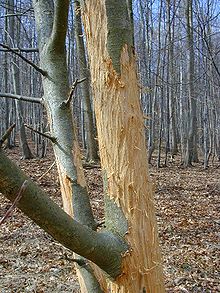Peeling
Under peeling means the nibbling of pieces of bark (in winter) or the removal of whole beef strips (in summer) of trees mainly by deer and other deer species. Only bark that is not very thick is peeled.
The most common peeling game species in Germany is the red deer. It lives in packs and can peel a forest stand "overnight". Deer do not peel. The gnawing of the bark by hare or wild rabbit is not referred to as peeling, but the effects of the curling around the trunk correspond to the major peeling damage.
There is no agreement on the causes of the peeling behavior. On the one hand, peeling is attributed to excessive stress, caused by the disquiet of the game in the event of high hunting pressure or heavy recreational traffic ; on the other hand, peeling can be part of natural food intake.
A distinction is made between summer and winter peeling. In summer the bark of the forest trees has a high water content, is therefore soft and can be peeled off in long (bast) strips. In winter the water content of the bark is low. It is difficult to remove from the wood and can only be “gnawed off” piece by piece. If the bark around the trunk is not completely removed, the tree will usually survive and overwhelm the damaged area.
Sensitive economic peeling damage occurs when the exposed wood is colonized by wood-destroying fungi such as the root sponge .
Preventive measures can be of a hunting nature (effectiveness is disputed) or directly protect the forest. The construction of a forest culture fence or individual protective measures (coating the bark with chemical agents, wrapping the trunk with nets, scratching the bark with a bark plane, etc.) come into question.
If peeling damage occurs, the forest owner can usually demand compensation for game damage .
Similar phenomena are the browsing , the passage loss as well as the wrap (damage caused by digging up the topsoil by wild boar ).
literature
- Ilse Haseder , Gerhard Stinglwagner : Knaurs Großes Jagdlexikon , Weltbild, Augsburg 2000, ISBN 3-8289-1579-5
- Wolfgang Schwenke (Hrsg.) Among others: The forest pests of Europe. A manual in 5 volumes. Volume 5: Vertebrates . Parey, Hamburg 1986, ISBN 3-490-11516-3
- Fritz Schwerdtfeger : The forest diseases. Textbook of forest pathology and forest protection. 4th edition. Parey, Hamburg 1981, ISBN 3-490-09116-7 .
- Oliver Trisl : Investigations for the development of an optimal sampling procedure for the long-term observation of the peeling damage situation. Hainholz, Göttingen 1998, ISBN 3-932622-11-1 .
Individual evidence
- ↑ Haseder p. 690

